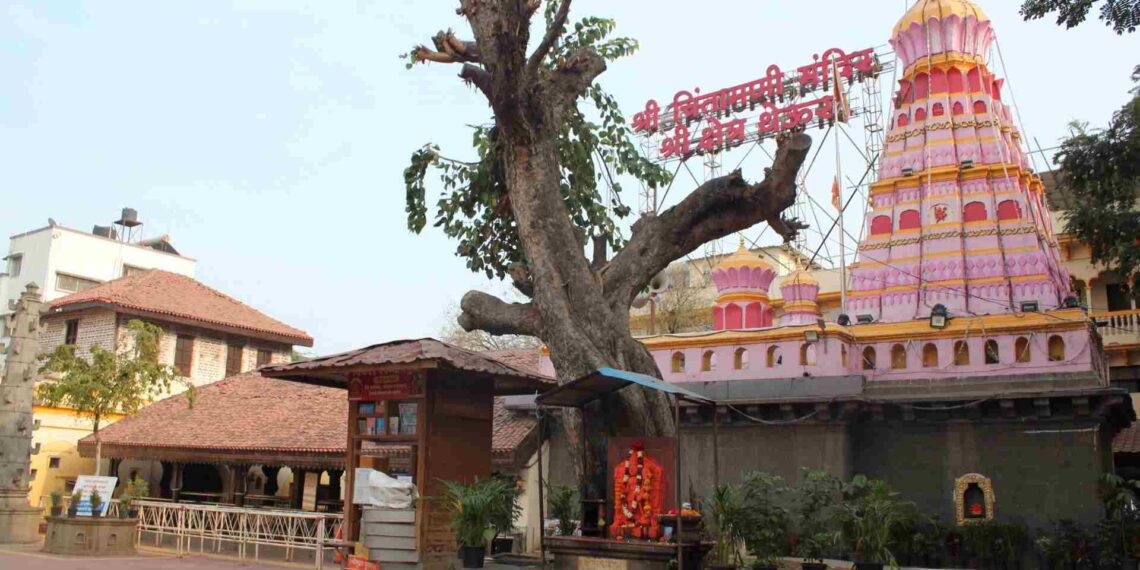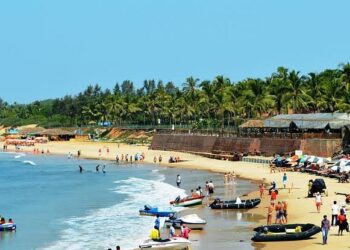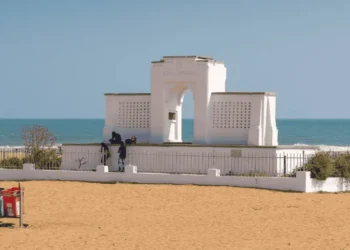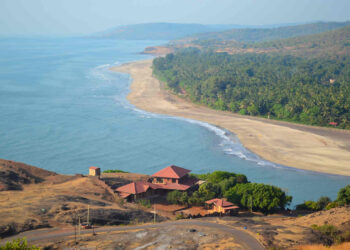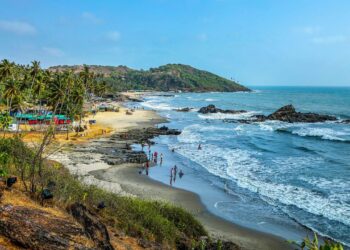Chintamani Temple located in Theur, Maharashtra is revered as the fifth Ganesha temple to be visited during the Asthavinayak yatra. Dedicated to Lord Ganesha as Chintamani, the temple is set by the Mula-Mutha River, about 25 km from Pune spanning roughly 1 acre in area.
Historical Overview
Though the temple is believed to have existed since antiquity, the current structure of the temple was built by the descendants of Saint Morya Goswami. Theur, a quiet village 25 km from Pune, was a spiritual spot. Old texts and local talk credit Morya Gosavi, a Ganesha devotee, with starting the temple before the 17th century. The Peshwas, Maratha rulers who revered Ganesha, added halls and walls in the 1700s, as stone writings show. The temple faced damage during invasions in the 1600s, but devotees hid the Ganesha idol in a nearby cave to keep it safe. It was rebuilt in the 1800s with help from local chieftains, notably the Peshwa rulers, who held Theur as a key place of worship.
Mythological Importance
It is believed that once Lord Brahma, the creator, was feeling restless and to ease his mind, he called upon Lord Ganesh. The place where Brahma achieved the serenity is known as the Sthavar region or as Theur. As Lord Brahma’s worries (Chinta) were removed by the Ganesha, Lord Ganesh is known here as Chintamani Vinayak. A legend says that once a young prince (son of Gunavati and Abhijita) by the name Guna, visited sage Kapil who offered the best of food to the prince, with the powers of Chintamani Ratna [a precious stone]. Impressed by the ratna, Ganaraj wanted it for himself, but when Kapilmuni refused to part with the ratna, he forcibly took it away from him. The sage prayed to Lord Ganesh for help and the Lord restored the gem from the prince. But by then Kapilmuni had lost all desire to possess the Chintamani ratna and he offered it Lord Ganesh. He tied the Chintamani Ratna around Lord Ganesh’s neck and so he came to be known as the Chintamani Vinayak. Since all of this occurred under a Kadamba tree, Theyoor was also known as Kadambanagar. The temple is for Lord Ganesha, believed to grant peace and remove worries.
Temple Architecture and Design
The Chintamani Temple in Theur, Maharashtra, is constructed in the Peshwa architectural style, a refined 18th-century Maratha design that integrates devotion with the village’s natural setting. Positioned beside the Mula-Mutha River, the temple rests on a modest stone platform with a prominent spire. The entrance, restored in the 1800s, features precise stone carvings of Ganesha holding a modak, accompanied by celestial figures and floral motifs within geometric borders. Painted in pale yellow and saffron tones, the spire is topped with a polished kalasa that reflects morning sunlight. The sanctum contains a black-stone Ganesha idol, adorned with silk cloth and floral garlands, placed beneath a silver-plated vimana with a tiered structure symbolizing spiritual elevation. The sanctum’s aged walls bear subtle Peshwa-era inscriptions of Ganesha’s legends, illuminated by ghee lamps.
Surrounding the main shrine are smaller altars for Vishnu, Laxmi, and Kartikeya, each sculpted from local granite and housed under open pavilions with carved columns. The Vishnu altar, near the river, displays an idol with a conch, its base engraved with wave patterns. The Laxmi altar, in the courtyard, portrays the goddess with coins, inviting prayers for prosperity. The Kartikeya altar, opposite Ganesha, depicts him with a peacock, representing strength. These altars, though understated, unify the temple’s worship, providing varied avenues for devotion.
A stone pathway from Theur village, lined with tamarind and mango trees, leads to the temple. The courtyard, paved with polished basalt, maintains a sacred ambiance, shaded by large peepal trees. A ritual pond, connected to the river, features steps with turtle carvings, a hallmark of Peshwa craftsmanship. The temple’s outer walls, constructed from rough stone, include niches for serpent deities, believed to protect the site.
Rituals and Festivals
The Chintamani Temple hosts numerous rituals and festivals dedicated to Lord Ganesha. The primary festival, Vinayaka Chaturthi, held in August or September, commemorates Ganesha’s birth. Devotees gather to offer modaks and chant hymns, participating in processions illuminated by clay lamps. Priests conduct the Sahasra Modak Homam, a distinctive ritual involving 1,000 modaks offered in a fire ceremony. Magha Chaturthi, observed in January or February, includes a Maha Abhishekam, where the idol is anointed with saffron-infused water amid Vedic recitations. Monthly, Sankashti Chaturthi attracts worshippers who fast and circumambulate the sanctum with lit lamps to overcome obstacles.
Daily rituals start with Pratah Puja at dawn, awakening Ganesha with bells and chants, followed by Madhyana Aarti with floral offerings. The evening Sayan Puja concludes with soothing hymns and camphor flames. Devotees can arrange special rituals such as Ganesh Kavach Pathan or Tulsi Archana for personal blessings. Exclusive to Theur, Kesar Modak Archana, performed on Thursdays, involves offering saffron-infused sweets. The temple’s Bhojan Seva provides free meals of rice and dal to pilgrims during festivals. A stall near the sanctum distributes prasad of sesame laddoosto the devotees..
How to Get There:
Air: Pune International Airport, 30 km away, is nearest. Taxis take 45 minutes, costing 1000-1500 rupees.
Train: Pune Railway Station, 25 km away, links to Mumbai (3 hours) and Hyderabad (12 hours). Autos to Theur cost 200-400 rupees.
Road: Theur is 25 km from Pune. Buses from Pune’s Swargate Bus Stand (45 minutes) stop at Theur village, 1 km away. Autos cost 20-40 rupees.
Best Time to Visit: October to March has good weather, 20-30°C. Weekdays are calm. Ganesh Chaturthi packs crowds, so book early.
